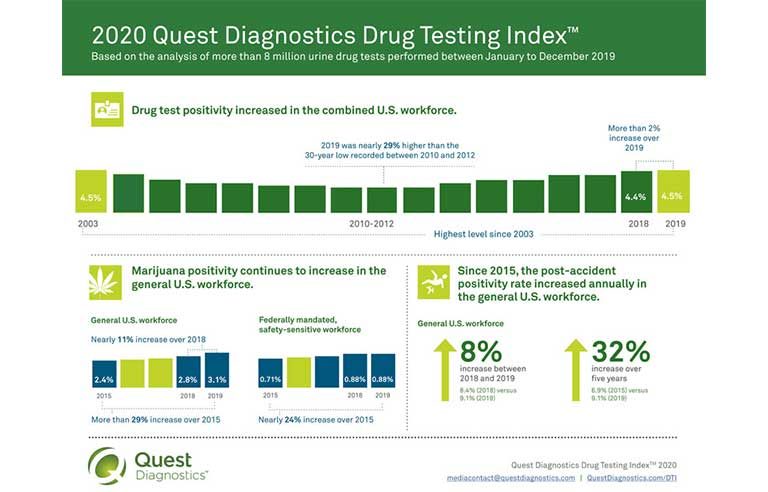‘Disturbing trend’: Positive drug tests for U.S. workers at 16-year high

Secaucus, NJ — U.S. workers in 2019 tested positive for illicit drugs at the highest rate in 16 years – an uptick that could continue this year as a symptom of the COVID-19 pandemic, according to an annual analysis by lab services provider Quest Diagnostics.
Researchers examined the results of more than 9 million samples taken last year for Quest Diagnostics’ Drug Testing Index from the combined U.S. workforce – both the general workforce and employees in safety-sensitive jobs who undergo federally mandated drug testing. Overall, 4.5% of the samples were positive – the highest percentage since 2003 (also 4.5%) and an increase from 4.4% in 2018.
“There is no question that before COVID-19, rates of workplace drug positivity were trending in the wrong direction,” Barry Sample, senior director of science and technology for Quest Diagnostics, said in an Aug. 25 press release. “The enormous strain caused by COVID-19 may prove to be an accelerant on this disturbing trend. Organizations will need to consider the impact of COVID-19 not only on workplace safety but also as a health concern for their employees for some time to come.”
Other findings:
- Methamphetamine positivity climbed almost 12% from 2015 to 2019 (to 0.19% from 0.17%) in the overall workforce. This includes a rapid increase in the Midwest, where rates increased almost 78% – to 0.16% from 0.09% – over the five-year span.
- From 2015 to 2019, positive tests for cocaine in the West rose to 0.23% from 0.15% – a 53% increase. The Midwest experienced a 40% increase in cocaine positivity over that span, to 0.28% from 0.2%.
- Marijuana remained the most commonly detected illicit substance across all workforce categories and specimen testing types. From 2018 to 2019, marijuana positivity in urine samples increased almost 11%, including jumps of 24% in the West and 14% in the Midwest. “Marijuana continues to be an enduring presence in the U.S. workforce,” Sample said. “Changing attitudes toward its use could pose heightened risks, especially in safety-sensitive positions and those states exploring legalization.”
- Positive urine tests for opiates decreased more than 19%.
Post a comment to this article
Safety+Health welcomes comments that promote respectful dialogue. Please stay on topic. Comments that contain personal attacks, profanity or abusive language – or those aggressively promoting products or services – will be removed. We reserve the right to determine which comments violate our comment policy. (Anonymous comments are welcome; merely skip the “name” field in the comment box. An email address is required but will not be included with your comment.)

